danbricklin.com/log
|
|
|
See also:
RIM Keyboard, especially the Test Results of the time trial
Another PDA plug-in: a camera for the Visor
|
Stowaway Keyboard
|
I'm putting all my material about the Stowaway keyboard from Think Outside on this page. Some of it repeats material on my log and Comdex Journal, but my reactions to actually using it are new.
How I got it
I lucked out and got a new toy to take with me to try at Comdex: a Stowaway portable keyboard for my Palm III PDA. It's from a new company called Think Outside, made up of people who worked on lots of mechanically neat devices at companies like Apple. It is about the size of the Palm III, but unfolds into a full keyboard you plug the PDA into. To use it the first time, you run a simple file off of a floppy (in the preproduction model I have), sync the Palm III, and it's ready. Here's what it looks like folded and then unfolding:
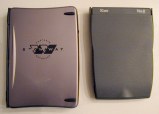 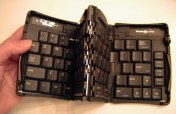 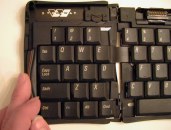 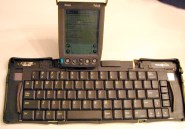 Unfolding the Stowaway keyboard and plugging in my Palm III
The unit I have is a preproduction one which still has some bugs. Despite them, it works quite well and I wouldn't want to give it up. I got it because the PR folks working with the company knew I'd walk around Comdex showing it off, which I did much to their delight. Lucky me! I also had the pleasure of showing people something that amazed them and made me look up to date with the latest in technology. The manufacturer plans to ship versions for various palmtop computers starting late this year or early 2000 for about $99.
What have I learned?
The Stowaway keyboard feels very much like the keyboard on my ThinkPad 600E laptop. I planned to use it to take notes during the day at Comdex so I wouldn't have to schlep around my laptop. I only got to use it a little bit at Comdex. What I did find out at Comdex was the first major observation:
This is a show stopper toy. Everybody wants to see it. If you take this out to use, people will notice and comment. I even got to talk with a famous movie maker because he saw me demonstrating it to a friend and came over to try it:
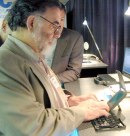 Francis Ford Coppola trying it
Another observation: People like the feel. It is very close to the best laptops. People with large fingers are especially happy. I have comments typed on it by a variety of people as they tried it saying (typos theirs):
This is a foldablekey boare and itworks very well and I can type very fastg on it and if you llike it, then you can do it.Wow.This is very nice.hwkkik rrg==thisis a very nice keyboard ISJUST LIKEA
There is a delay in the keystrokes showing up on the Palm III screen, so you make a few more errors when you first try it. That takes a little getting used to, but is not much of a problem if you are a touch-typist with reasonable skill. Also, on my unit the space bar needs to be pressed a little harder to register the key (there is separate "space" key you can use instead, too).
I used it at breakfast one day to work on an essay I was writing. I found the normal Memo application on my Palm III too restricting because it can only handle about 800 words per memo -- a lot for handwriting input, but too little for a keyboard. This implies that new applications open up with the availability of a good keyboard. [In my on-going Stowaway log I address this issue and get more software.] Also, for my old eyes, I had to go to the larger type to make it easily readable at a typing distance. I loved using the arrow keys to scroll through reading. Nicer than a pen.
There was one other time when I used it. I was in my hotel room entering contact information from a business card into my Palm III. I kept messing up on one of the characters. I took out the keyboard and typed in the rest of the entry, typing more than I would normally have had the patience to write in. I also found it no slower than firing up the Palm Desktop software on my laptop (which was already running) to enter it there.
My main observations about using it were during a Massachusetts Software Council Executive Board Meeting. Several of us were sitting around a table early in the morning. I sat next to Deb Besemer (CEO of HireSystems) who was taking notes about the meeting on her ThinkPad 500-something, I took out my Palm III and keyboard to write down some thoughts I had (yes, there were a little bit of "oohs and ahhs", though I tried to be discrete):
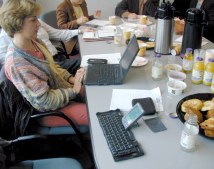 Using the keyboard at a meeting
First of all: You can take the keyboard out real fast to get it set up. It takes about 15 seconds to take the keyboard out of a briefcase, open it, and insert the PDA. (Less time than it takes for Windows to wake from Standby mode on my machine.) People will not notice it as much as taking out a laptop and opening it up and going through a (noisy) boot sequence. Once you have it set up, it is really instant on each time you use it: As soon as you touch a key the Palm III comes to life. It also only takes one keystroke to turn the PDA off. You can even turn the backlight on and off with a keystroke.
Another observation: It has a much lower profile on the table than a laptop. You don't feel like you are peering over a large screen to see people. It (and the PDA) are lower than the juice bottles:
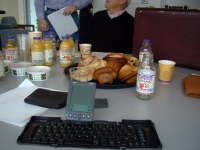 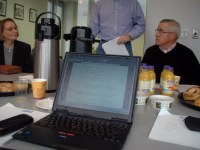 PDA and keyboard vs. laptop
I found that it was much better for taking notes in a meeting than paper or writing on the PDA because the keys (except for the space bar) are relatively silent even compared to my laptop and, as a touch typist, I could type while still looking at the person speaking. Much less intrusive.
My notes at the meeting (about the keyboard -- I took others, too), cut and pasted here after syncing:
Use of Palm in meeting with Stowaway: Instant on, silent, can jump around all the parts instantly and less obtrusive since can type without looking at screen. Next to laptop looked futuristic. Took top off so won't have blatant start/stop. Low profile so not looking over screen at people.
A lot cleaner than what I usually get writing on the Palm III (I'm not the greatest with the pen handwriting recognition).
My comment about jumping around is that you can switch between calendar, memo, etc., using the dedicated buttons on the keyboard. You rarely need to go to the pen once you learn the shortcuts. I removed the flip top on the Palm III because I found myself opening and closing it when I wanted to type, signaling that I was about to care about my typing more than the meeting. With it off, the whole thing felt very natural and polite, no worse than a pad of paper and better than a laptop.
I do not usually take notes on a PC during a meeting. I find a laptop too cumbersome and intrusive. But I always lose the paper notes unless they are in a notebook, and I can't email them. This keyboard changes things for me. I think use in meetings will be a major reason for purchase. For those that use their PDA for email, my notes say "this must be super".
Being able to quickly add keyboard input to other portable devices could be quite useful, too. I'd love to have a cable that would connect it to a video camera for titling or to my cellphone for entering names and numbers. Maybe the new wireless technologies (Bluetooth, etc.) will let me do this. Hopefully, those devices will be built general purpose enough so, like my Palm III, they can add a new capability years after the device is designed.
That's it from one week of observation. I'll keep using it and see if I continue to like it and post observations in my log. I'm also keeping an on-going log in my "Living with the Stowaway Keyboard" page and report on a use on a racing boat in "Stowaway sightings". In early 2001 a new word processor was released for the Palm OS that is optimized for the Stowaway (see my review). You may also want to read about the time trials I did vs. other input devices in my write-up of the tiny RIM Keyboard, or see sample pictures taken with the Visor eyemodule digital camera. Another write-up is on Hugh Peeble's Hugh's News June 2000 page.
If you're new to this web site: This is my personal web site. I have information about me (www.bricklin.com) and an ongoing log (danbricklin.com/log).
This web site was created using Trellix Web from Trellix Corporation, a great authoring tool for easily creating and maintaining Web sites -- and it can be totally FREE in many cases (as described on the web site). You can make a professional site yourself in under an hour. There's no messing with HTML, no touching FTP, and you don't have to be a graphics designer. You can download it today and try it for free. (Disclaimer: I founded Trellix and am the CTO...)
|
|
|
© Copyright 1999-2018 by Daniel Bricklin
All Rights Reserved.
|